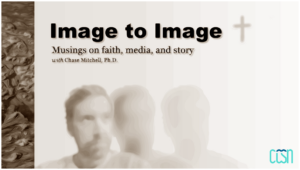 Column: Image to Image: Musings on Faith, Media, and Story
Column: Image to Image: Musings on Faith, Media, and Story
December entry: “The Masters, the Master, and Love Belied”
Column Description: Image to Image: Musings on Faith, Media, and Story is a monthly column that illuminates old and new ideas about media ecology from a Christian perspective. Dr. Mitchell will explore what it means to bear God’s image and Christian witness in a mediated world, with a particular focus on the relationships between theology, media, and orthopraxy across different Christian traditions.
By Chase Mitchell, Ph.D.
Assistant Professor of Media and Communication, East Tennessee State University
April 2025 / March 2025 / February 2025 / January 2025 / December 2024 / November 2024 / October 2024 / September 2024 / August 2024 / September 2023 / June 2023 / January 2023 / September-October 2022 / July 2022 / June 2022 / April-May 2022 / January 2022 / November 2021 / October 2021 / September 2021
The Masters, the Master, and Love Belied
April 2025
I’ve written elsewhere, as have many others, about the psychological and spiritual effects of digital technologies.[1] It’s become abundantly clear to everyone who thinks about these things that our digital liturgies—our daily habits and practices online—have (mal)formative power. Our devices, and the digital lifestyles they foster, not only make it harder to focus and increase anxiety; they also play a significant role in shaping our affections.
To put it another way: our digital liturgies form and reform our hearts because they’re designed to amplify desire. Unfortunately, technologists are very good at engaging and exacerbating our unhealthy desires, such as power, lust, personal glory, and tendency to idol worship (of fashionistas, footballers, or First Families).
Christians lament digital technology’s often-negative influence in modern culture. Many attempt to find healthy ways to disengage, such as limiting screen time, “fasting” from digital technologies, and generally being mindful of its potential harmful effects. We recognize the ubiquity of the problem, which is why it’s so striking to see exceptions to the “digital rule,” like what happens every spring at The Masters golf tournament in Augusta, Georgia.
The Masters is the only one of the four major golf tournaments that doesn’t allow spectators to bring their digital devices onto the course. The rule is strictly enforced, and violations risk removal from the grounds and even a lifetime ban from the event. Interestingly, patrons have consistently reported that the rule is a great thing. It’s not a necessary evil that guests must abide in order to attend the tournament; rather, they’ve said that it improves the experience by minimizing distractions, encouraging presence, and respecting (and maintaining) tradition.
This voluntary forfeiture is surprising, indeed, given the ferocity with which most people resist turning over their phones even when they have to—during jury duty, for example. Why the exception, here? Why does The Masters inspire such Luddite spirit in otherwise red-blooded American technophiles? I think it’s because The Masters captures Americans’ hearts in ways that border on religious devotion.
People yearn for beauty. They desire embodied experience. And despite the human tendency to rebel, to tear down, the human need for tradition, for building up, is a real thing. The Masters has created and cultivated a place, an experience, and an ethos that celebrates all of these. And because fans intuit the goodness of embodied traditions (liturgies)—increasingly lacking in our digital lives—patrons are all-too-happy to give up their phones and immerse themselves in the tournament experience.
I’m not saying that The Masters is or should be a religious rite. Actually, I think it borders on idol worship, at least in its most fervent devotees. For some, the trip to Augusta National has become a pilgrimage. Rather, what I’m saying is that what it reveals about us is very important. Which is this: We can pay lip service to values, and worldviews, and even faith, but the eyes are honest whereas the mouth is not. We pay attention, that is, to the things we love. Our hearts are revealed in what, and who, we revel in.
Many Christians attend The Masters and I’m sure enjoy it in appropriate ways. I wonder, though, how many of them would be so willing (much less so excited) to leave their phones at home not just on Masters Sunday, but every Sunday. Do they find the same joy in the embodied, liturgical, personal encounter with other Christians, in attentive worship, that they do at Augusta? At the college football game? At the concert? If the answer is no, and I suspect it is in too many cases, there is something wrong.
What we attend to—willingly, joyfully, and (yes, Protestants) liturgically—belies our desires.
The Master, Jesus, is more desirable than even our most treasured cultural totems. But of course, one cannot force desire. The heart wants what the heart wants, we like to say. So what do we do? As Thomas Aquinas wrote, to love is not (primarily) to experience a feeling. Rather, to love is to will the good of the other. The work of the Church is to reveal God’s beauty by willing others’ good, even (and especially) when that work is not desirable. By attending to the least beautiful, by loving those who cannot yet perceive Christ’s truth, we ourselves come more and more to see the excruciating beauty of the Cross.
Then, in time, we perceive the splendor of His Church—her saints, her sacraments, and her traditions—and drape ourselves in her garments. They are much finer than a green jacket.
Note
[1] For an excellent recent book on this topic, see Samuel James’ Digital Liturgies: Rediscovering Christian Wisdom in an Online Age (2023, Crossway).
